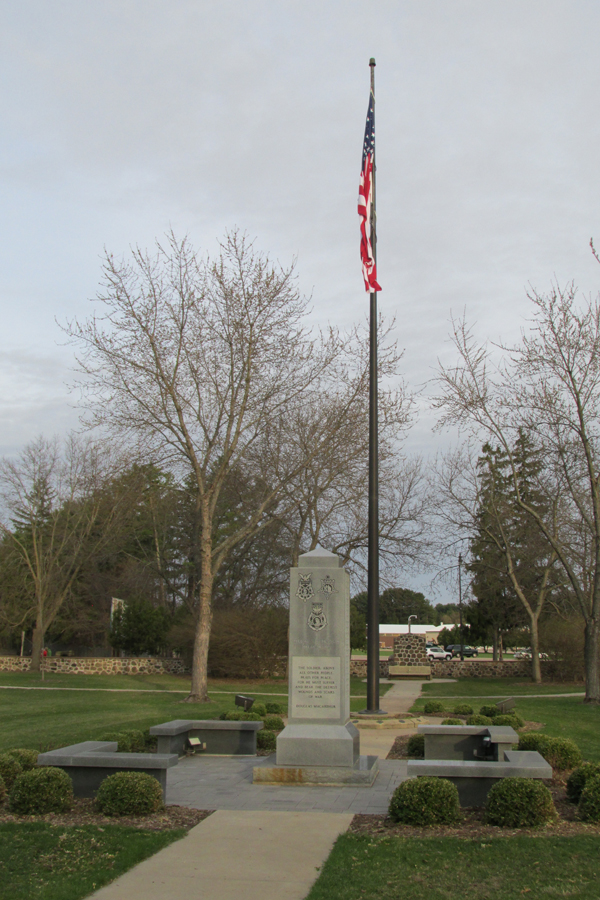Wisconsin Medal of Honor Monument in King – Anomalies & Errors

Who Is a “Wisconsin” Medal of Honor Recipient?
While it’s not entirely clear, the Wisconsin Medal of Honor Monument (MOHM) seems to have been erected by the Wisconsin Department of Veterans Affairs (WDVA). It is located on the campus of the Wisconsin Veterans Home in King, WI. It was dedicated in 2012 to honor the 63 “Wisconsin” Medal of Honor recipients.
Creating a monument or memorial of this type – attempting to list “all” veterans within a certain criteria – is fraught with complications. Cushing’s name had to be added to the MOHM after it had been dedicated. No matter how meticulous, the research is going to be left wanting.
Apparently, the criteria for inclusion on this list was 1) Medal of Honor recipient; 2) who was “born in” or 3) had “resided in” the state of Wisconsin. The first criterion is fairly clear-cut. However, an entire list of recipients born in Wisconsin were left off the MOHM. And, in a few cases, “resided in Wisconsin” seems to have been quite freely interpreted.
For example, these recipients are listed on the MOHM:
- John Hayes was born in Newfoundland, Canada, and enlisted in the Union Navy from the state of New York. He did not reside in Wisconsin until after his Navy service ended in 1868. Is he a “Wisconsin” Medal of Honor recipient?
- John T Patterson was born in Ohio and served in the 122nd Ohio Infantry during the Civil War. Twenty years after the war ended, he moved to Wisconsin. Is he a “Wisconsin” Medal of Honor recipient?
- Alonzo Cushing‘s was born in Delafield, WI, but it appears that his family had left the state by the time he was four (4) years old. He was raised in Chautauqua County, New York. He was admitted to West Point and graduated in 1861. Does his birth and few years as a toddler in Wisconsin qualify him as a “Wisconsin” Medal of Honor recipient?
These Medal of Honor recipients were left off the MOHM:
- Orson W Bennett served as a 1st Lieutenant in Company A, 102nd US Colored Troops during the Civil War. But before he was commissioned in the USCT, he had enlisted from Hazel Green, WI; and served as a Private in Company G, 12th Wisconsin Infantry. He served over two years with the 12th Wisconsin. Is he not a “Wisconsin” Medal of Honor recipient?
- These Medal of Honor recipients, who enlisted from other states, like Alonzo Cushing, were all born in Wisconsin; but, unlike Alonzo Cushing, they were left off the MOHM:
-
- Harry Bell, born in Milwaukee, WI
- John B Kinne, born in Beloit, WI
- Edward E Lyon, born in Hixton, WI
- Marcus W Robertson, born in Flintville, WI
- Deming Bronson, born in Rhinelander, WI
- Charles W Whittlesey, born in Florence, WI
- Orville E Bloch, born in Big Falls, WI
When was the Mexican War?

Surrounding the flagpole at the MOHM is a series of bronze medallions, which appear to be re-purposed gravesite flag holders.
The MOHM designers intended to recognize each of US wars – in chronological order.
They failed.
The medallions are not in the correct order and the conflict they had apparently intended to honor is not represented at all.
The United States annexed the state of Texas in 1845 and the Mexican War ensued in 1846. The US Army doubled in size and twice as many volunteer regiments were raised from 25 states.
Wisconsin was not yet a state, so patriotic volunteers traveled to nearby states to enlist. Wisconsin actually furnished one company of volunteers which were nominally referred to as a territorial militia.
Seventy years later in March 1916, the Mexican revoltionary Pancho Villa attacked a small Army garrison in Columbus, NM, and then immediately withdrew across the border.
The United States’ military response has several names: Pancho Villa Expedition, Mexican Expedition, Punitive Expedition, Border War, Border Campaign, etc. It is now known as the Mexican Border Campaign.
National Guard units were federalized to active duty for the first time in 15 years and by July 1916 over 100,000 guardsmen were serving along the border. Wisconsin sent three (3) regiments – over 4,000 men. The only action they saw was during an exercise to “defend” New Braunfels, TX, from an opposing force of other national guardsmen. However, the training and experience would be invaluable when the Wisconsin National Guard was again federalized for World War I a year later.
To summarize:
- Mexican War, 1846-1848
- Mexican Border Campaign, 1916
 This medallion is inscribed “Mexican War Veteran”. It was installed between the medallions for the Spanish-American War (1898-1899) and World War I (1917-1918).
This medallion is inscribed “Mexican War Veteran”. It was installed between the medallions for the Spanish-American War (1898-1899) and World War I (1917-1918).
Clearly, this medallion was intended to reflect the Mexican Border Campaign, which occurred between those two wars.
To the best of my knowledge, no bronze flag holder was manufactured for the Mexican Border Conflict.
Sadly, it appears that these medallions were somehow embedded in the concrete as it was hardened. To correct this mistake, the “Mexican War” medallion needs to be installed between the War of 1812 and Civil War medallions; which would require moving a total of four (4) medallions – leaving no recognition for the Mexican Border Campaign.
The following table demonstrates the errors in the sequence of the installation of war medallions at the MOHM: